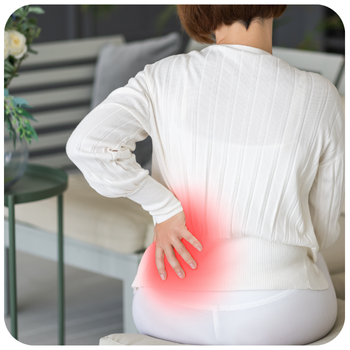Lower back pain
Most people suffer from low back problems at some point in their lives. It's very common and usually doesn’t mean your back is seriously damaged, though it can be very painful and worrying.
What should I do?
If you get low back pain for the first time, you usually don’t need to see a doctor or get any special tests like x-rays. Most of the time, the pain starts to get better in about two weeks and should be mostly gone by six weeks.
How can I help myself?
You can help yourself by keeping up with your normal activities and doing gentle exercises. Even if the pain lasts longer, there are still things you can do to feel better.
What about pain that spreads?
Sometimes, back pain can spread to your legs. But don’t worry—most of the advice is the same, and the pain usually improves a lot by 12 weeks without special treatment.
Low back pain can happen for many reasons:
- Changing your activity: If you suddenly start doing more or less physical activity than usual.
- Injuries: Getting hurt by lifting something heavy or in sports can strain your back.
- Long-term issues: Sometimes, old back pain can flare up for no clear reason. Other health issues like arthritis or fibromyalgia might also be involved.
- Other factors: Things like being out of shape, feeling stressed, not sleeping well, or feeling down can also lead to back pain. Smoking, being tired, and feeling run down can be factors too.
Even though low back pain can be scary, it’s usually not dangerous and isn’t caused by getting older or poor posture.
For more information, you can read these 10 back facts or visit the Chartered Society of Physiotherapy website.
Read information specifically about low back and leg pain (Sciatica) and lumbar spine stenosis.
Watch the video below for further advice and information.
When your back pain starts, it's a good idea to do less of what hurts, but you should also try to stay active.
Start moving again
Get back to being active slowly. You can do activities you enjoy, like walking, gardening, swimming, cycling, or yoga.
Feeling uncomfortable is normal
At first, moving might feel a bit uncomfortable, but that’s okay. Remember, feeling pain doesn’t always mean you’re hurting yourself. Your back is strong and made to move, so take it step by step.
Going back to work
If you’ve had to take time off work, talk to your workplace about returning. You might start with shorter hours or lighter tasks.
Take care of your feelings
Feeling down, tired, or stressed can make your pain worse. Try to get good sleep and talk to friends or family for support.
Need more help?
For more information, read this low back pain booklet or visit the links at the side of the page. You can also refer yourself to the MSK Together physiotherapy service.
In very rare cases, back pain needs immediate attention. Look out for back and leg pain with any of these new signs:
- Loss of feeling: If you feel numb or have pins and needles between your legs.
- Changes around your bottom: If you notice strange feelings around your back passage or buttocks.
- Bladder problems: If you can’t control your bladder, have trouble stopping the flow of urine, or don’t know when your bladder is full.
- Sexual issues: If you have new problems with feeling in the vagina or trouble with erections or ejaculation.
If you have any of these symptoms, contact your doctor or NHS 111 right away, or go to the Emergency Department.
Pain medicines are not a cure for back pain. Talk to your pharmacist, doctor, physiotherapist or nurse about which pain medicine to choose in the short term to help you to get moving again.
Long term and regular use of pain medicines could cause harm, so remember - exercise works better.
Scans, such as MRIs and X-rays, help to provide a picture of the spine. They can be used to help plan treatment or rule out serious conditions like cancer or a fracture. But scans can't show us how well our backs, nerves and muscles are functioning; they also cannot tell us why we are in pain.
For these reasons, scans do not give a diagnosis. This is where an assessment with a health practitioner is more useful.
For most people (in fact 95% of people) with neck or back pain, scans are not needed and can cause more worry and anxiety which may negatively affect your recovery. We also know many of the changes seen on an MRI will often be seen in people without back pain.
For more information about a spinal MRI and the results report, visit the NHS England website.
Below are some examples of early exercises designed to improve your mobility and function. They can be done several times a day, little and often. You can also visit the BACK Tracks website, an exercise platform to help people with back pain explore movement.
Walking (or another active activity of your choice)
- Keeping active is one of the most important things you can do for your back. Pick an activity that you enjoy like walking and try and do some daily. Anything which gets you moving, raises you heart rate and body temperature will help
- You can also visit the NHS Fitness Studio for some online exercise videos for people with back pain.

Mini squats
This is a great exercise to warm up the body and mobilise multiple muscle groups and nerves.
- Stand in front of a counter and chair and hold on for support
- Slowly lower into a mini-squat
- Start with a smaller movement before slowly progressing into the range over 60 seconds.
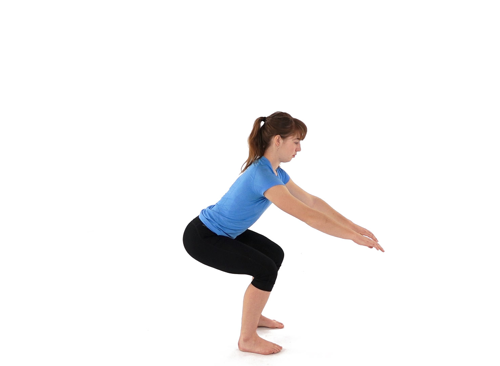
Marching on the spot
- Stand up with your feet about hip width. March on the spot, lifting your knees high. Keep the body straight as you do the exercise
- Initially holding onto a worksurface and lifting the knees half way is a easier starting position. Work over 60 seconds repeating two to three sets.
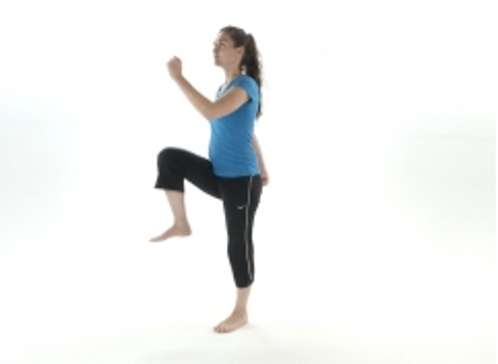
Pelvic tilt
- Lie down on your back
- Slowly flatten your lower back into the bed/floor by tilting your pelvis and tightening you bottom and lower tummy muscles before returning to the starting position
- If you can ease into this movement you can progress by gently arching your back i.e. tilting your pelvis in the opposite direction these movement can be performed in a alternating fashion with a slight pause between the two movements
- Work over 30 to 60 seconds.
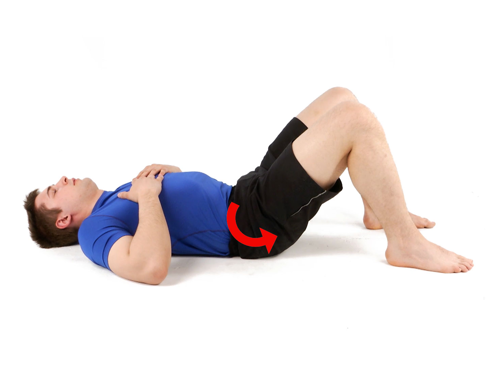
Knee rolls (spine rotation)
- Lie on your back with your knees bent and your feet flat on the floor
- Gently roll your knees to one side (while keeping them together) then the other
- The movement can start of relatively small and should come from your hips/pelvis and lower back
- You can have your arms by your side our stretched out to provide more support
- Repeat for 30 to 60 seconds.
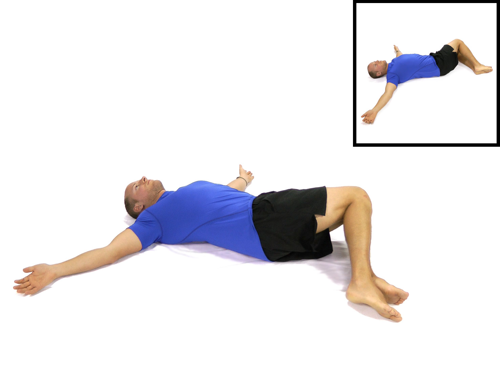
If you are in severe pain, below are a couple of positions to try to help relax your back and ease symptoms before getting moving.
Lying over pillows
- Lie on your stomach with one or two (as comfortable) pillows placed under your hips and stomach.
- Relax in this position for two minutes and repeat several times a day.
- You can progress by removing one or both pillows. The goal of this exercise is to reduce the pain felt in your back and legs but if this position worsens your symptoms stop and try the next exercise instead.
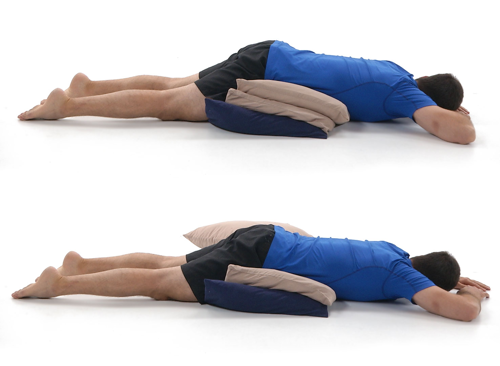
Low back release
This is a position to try if the last exercise (lying on your front)is uncomfortable.
- Lie on your back with your feet resting on a chair/sofa or alternatively just lie flat on your bed with your knees bent (you could experiment with a small rolled up towel in the small of your back). This should be a comfortable position and you may feel a gentle stretch or "traction" in the lower back.
- This position can be maintained for a couple of minutes and repeated several times a day if comfortable.
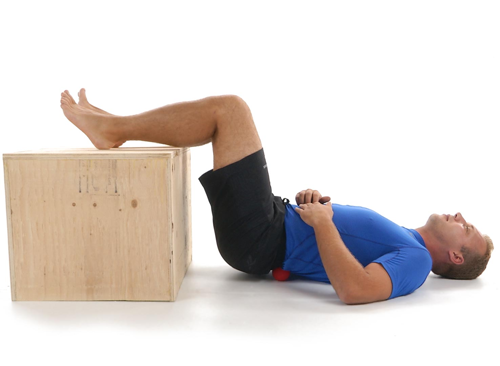
You can’t always prevent low back pain, just like you can’t always avoid catching a cold.
However, what’s really important for keeping your back and body healthy is:
- Keeping moving (exploring movement with varied activity and avoiding being in one position for too long)
- Keeping a healthy weight
- Getting good sleep
- Managing stress
- Quitting smoking
- Drinking less alcohol
- Staying active
Being active helps you avoid long-term pain and serious health problems like diabetes, cancer, and heart disease. It also helps you live a longer, healthier life. Just like lifting weights makes your muscles strong, moving and exercising your back makes it stronger and healthier. Start slowly and keep practicing to safely do things like bending and lifting.
Getting help for better health
Get free local help from Your Health Notts website to:
- Improve your fitness.
- Lose weight.
- Stop smoking.
- Reduce alcohol intake.
- Help with exercise
If you need help with exercise, ask your doctor about the GP Exercise Referral Schemes. These offer discounted classes at local leisure centres:
Information in this section is intended to be used as a guide. It gives you an idea about how low back pain can be managed. However, you should remember that every case is different, and symptoms and management can vary from person to person.

